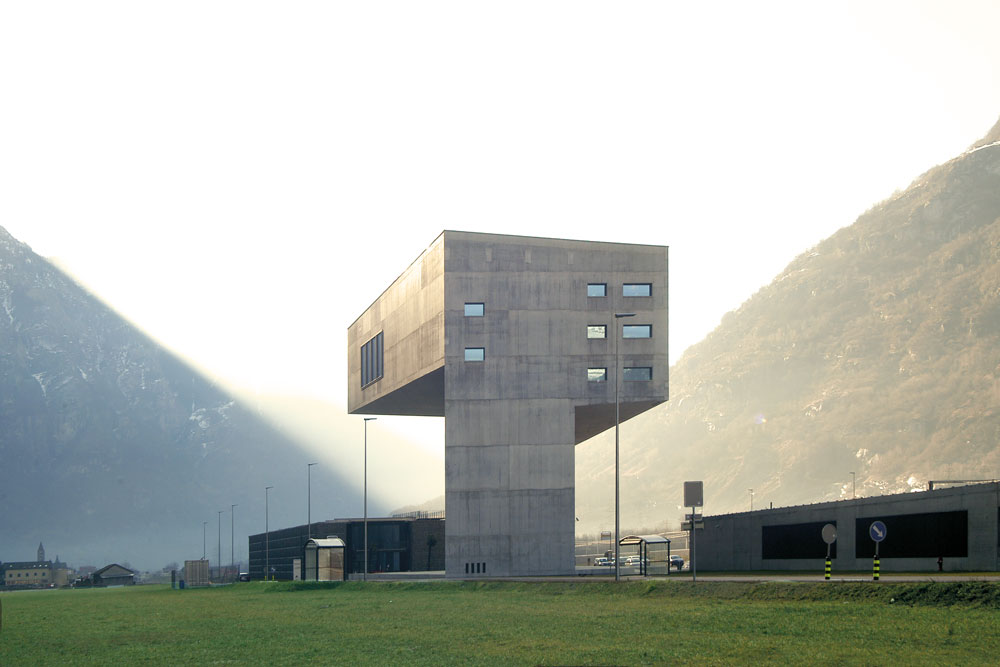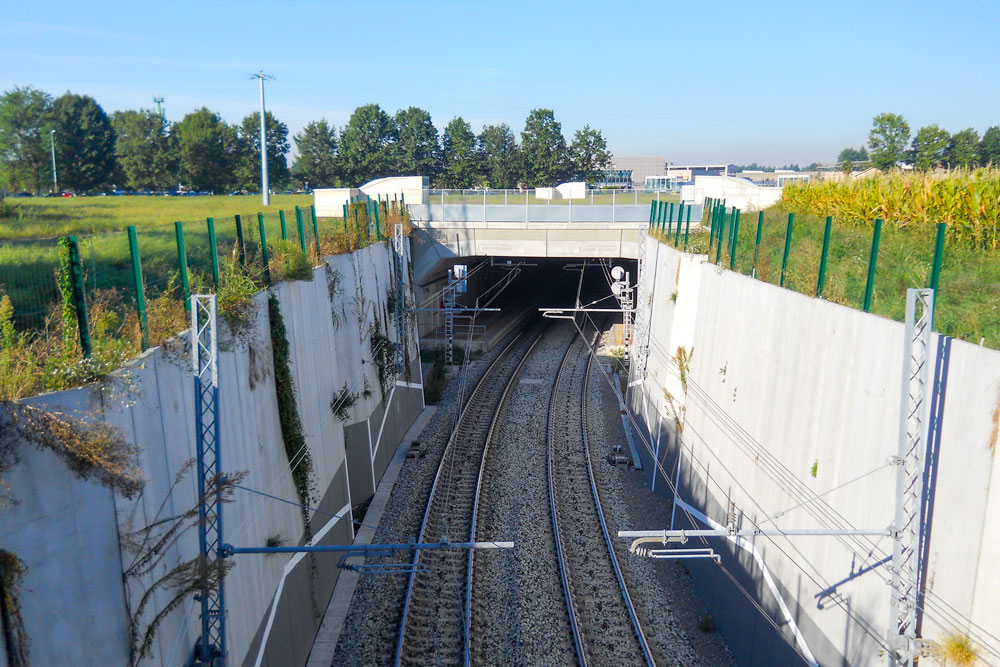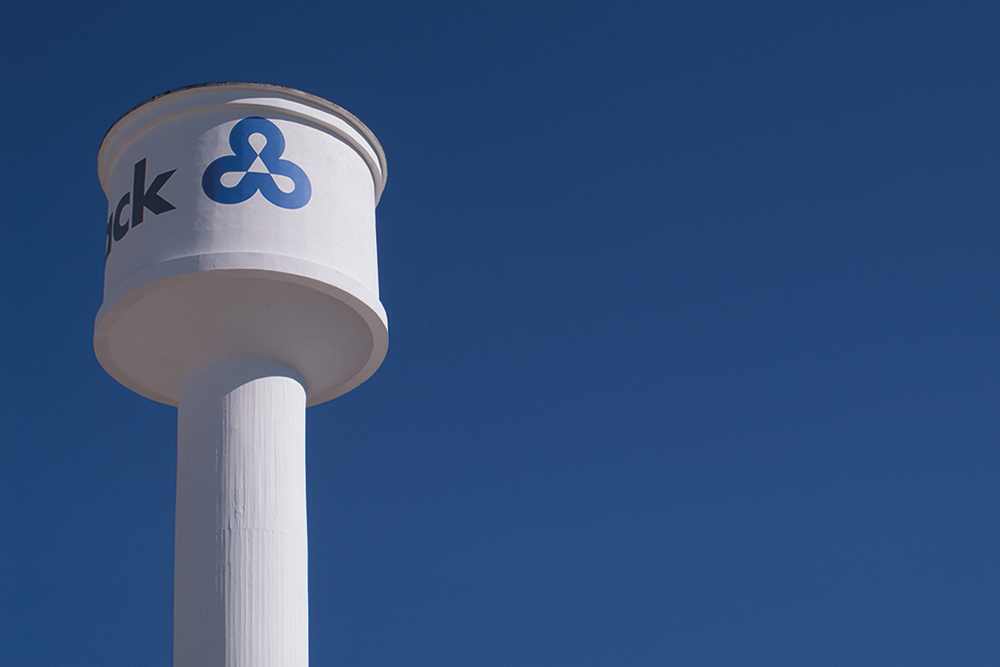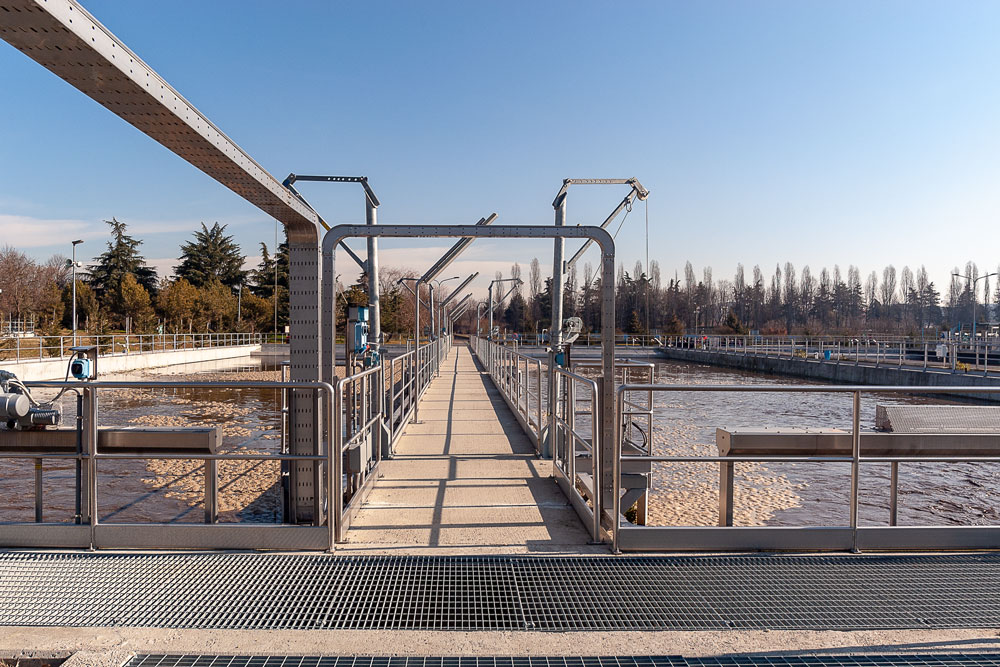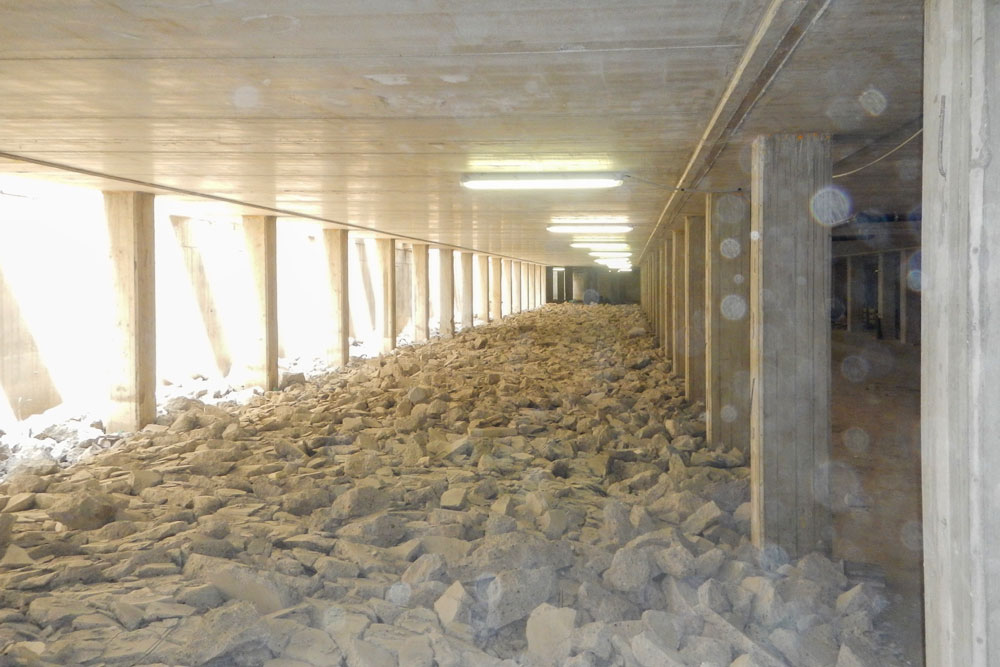Designing the house for a family of farmers and the farmhouse for their guests within a farm, without interrupting the precious continuity of an alpine landscape made up of orchards and sloping meadows.
An ambitious request, to which Studio Stefania Saracino and Franco Tagliabue Architetti gave a radical response, setting the Casa Riga directly in the mountain just outside Comano Terme, in Trentino.
The structures in contact with the ground, bed and walls in contact with the ground, were built with the Drytech Tank System.
Project: Saracino Tagliabue Architects, Bolzano / Como
Structure: Ing. Giovanni Periotto, Trento
Construction: Damiani-Holz&Ko, Bressanone
Energy: Energytech, Bolzano
Photo: Davide Cornacchini, Venice
Drytech Tank: 725 m²
Country
AlpTransit Control Center, Pollegio
by Luca Negri
The AlpTransit Polleggio Operation Center manages the railway traffic of the Gotthard and Monte Ceneri base tunnels.
Known as “The Periscope” for its futuristic architecture, the POC is one of the four SBB operating centers in Switzerland, together with the ultra-modern centers of Lausanne, Olten, Zurich.
Height and shape of the building are the architectural response to two functional constraints.
The POC marks and declares the entrance to the Gotthard base tunnel. It is a symbol.
To be perceived as such by the railway and the motorway it was developed in height.
The second constraint is the dimensional incompatibility between the control room and the type of an office building, which has led to accepting the contrast and expressing it in a radical way. Thus, the double-height slab of the control room is grafted onto a trunk of office space, arranged diagonally on the lot.
The AlpTransit Polleggio Operation Center therefore appears as a sculptural object animated by a twist between the two volumes.
Seen from a moving vehicle it transforms, changing its proportions and offering different states of balance.
Client: Canton Ticino logistics section
Project: Architetto Bruno Fioretti Marquez, Berlino
Structure: Ingg. Borlini & Zanini, Pambio Noranco
Construction: CSC, Lugano
Drytech Tank: 711 m²
Trenord railway underpass, Saronno
by Luca Negri
Then the excavation and casting of the Drytech waterproof concrete slab was carried out, resting on the bulkheads and prepared with the DRYset crack control elements. The whole operation took place in just three days, at the end of which the track was restored.
The procedure was therefore repeated on the other track. After another three days the line returned to full capacity, with both tracks open.
The excavation was then carried out under the slab, the casting of the platform floor of the underpass and finally the lining casting, directly against the micropiles.
When the concrete matured, joints, holes and programmed cracks were injected with DRYflex resin which, expanding, sealed them by pressure.
Drytech Engineering provided advice on aspects relating to waterproofing, collaborating with the structural engineer already in the design phase of the underpass.
Ownership: Ferrovie Trenord, Milano
Structure: Studio I.R. Ingegneri Riuniti – Ing. Giuseppe Barbagallo, Catania
Constraction: SALCEF Spa, Roma
Drytech Tank: 1,800 m²
Hotel Hilton, Como
by Luca Negri
Hilton Lake is the largest hotel on Como Lake.
Opened in 2018, it has 170 rooms, two restaurants, a spa with indoor pool, a state-of-the-art fitness center open 24 hours a day and a conference area divided into 6 modular spaces and a total capacity of 300 seats.
On the elegant rooftop on the top floor of the building, guests can enjoy the breathtaking view of the lake directly from an infinity pool – created by Drytech in a single waterproof concrete structure -, from the adjacent lounge bar with terrace overlooking the city gulf. or, on the opposite side, from the solarium with hydromassage.
The project by architects Dario Pietro Cazzaniga and Monica Limonta started with the redevelopment and renovation of two existing buildings: a former brick weaving house, which houses the entrance, reception and lounge bar Taffeta, and a rear body that has been completely redesigned on the large floor-to-ceiling windows of the rooms.
The two main bodies are connected by a modern glass structure that houses the lobby and reinterprets the lakeside tradition of greenhouses and winter gardens.
The whole structure, including the 21 suites, was furnished by the architects Cazzaniga and Limonta.
A global approach that is reflected in the elegant architectural and functional unity of the project and which places the structure at the top of the Lake Como hôtellerie.
Ownership: VICO SpA, Como
Project: AArch. Dario Pietro Cazzaniga e Monica Limonta
Structure: Ing. Filippo Valaperta – FV Progetti
Construction: Nessi & Majocchi SpA, Como
Drytech Tank: 120 m²
Nuvola Lavazza, Turin
by Luca Negri
The Lavazza Cloud designed by Cino Zucchi Architetti and the historic buildings recovered by Cino Zucchi himself together with Picco Architetti, are an example of architecture that dialogues with the neighborhood, with time and with the environment.
Over time, the area affected by the intervention has hosted the activities of the Alta Italia Electric Company, Sip and finally Enel.
A historic production site surrounded by a boundary wall.
The large block was opened and transformed into a pedestrian square overlooked by all the spaces, both newly built – the new Lavazza business center – and recovered.
A place that becomes an integral part of both the road system and the life of the neighborhood, with the large square-garden and its premises and with the underground public parking.
The environment helped shape the height of the building, which varies on different sides from six to two floors, depending on the solar orientation and the surrounding buildings.
The metal pilasters and stringcourses form an external grid on the floor of the windows which, depending on the seasons and the same hours of the day, helps to shield or favor the penetration of sunlight.
The uninterrupted dialogue with the environment includes roofs covered by greenery, hanging gardens inserted between the offices and a sophisticated digital system that programs the environmental parameters – such as temperature and lighting – in relation to the times and methods in which the different spaces are used, so as to maximize living comfort and energy efficiency.
Ownership: Lavazza, Torino
Project:
Cino Zucchi Architetti, Milano
Picco Architetti, Torino
Structure: Ing Giorgio Piccarreta – AI Engineering, Torino
Construction: Colombo Costruzioni, Lecco
Drytech Tank: 12,590 m²
Vetropack water tower, Corsico
by Luca Negri
Drytech restored the water tower of the Vetropack plant in Corsico with injections of waterproofing resin carried out from the outside, without having to empty the barrel.
The fire-fighting water reserve was thus guaranteed to the continuous-cycle industrial plants and the company did not have to rent a tanker for the fire brigade.
With the Drytech system it is no longer necessary to dive into the barrels, with all the related logistical and safety implications.
For the intervention, Drytech technicians exploited a scaffolding already set up by a company to restore the external surface of the tower.
Normally the Drytech Rehabilitation System allows the practical use of aerial platforms, with a consequent saving on costs and time for setting up the scaffold.
Client: Vetropack, Corsico
Restoration: Drytech Italia, Como
Denitrification tanks, Bresso
by Luca Negri
The Bresso Niguarda treatment plant was equipped with a new denitrification basin of 10,800 m³.
Wastewater denitrification is a process for the removal of nitrogenous compounds present in solution by optionally heterotrophic bacteria.
The part of the plant where the process takes place is a rectangular tank divided into two chambers of equal size, connected only superficially, which allow the continuity of the treatment, even when one of them needs to be emptied for maintenance.
Being a single waterproof concrete structure, the Drytech tank has the advantage of allowing maintenance interventions carried out from inside the tanks and immediately verifiable.
Ownership: CAP Holding SpA, Assago
Project: Ing.Gabriele Ghilardi, Bergamo
Work Management: Ing.Emanuele Calloni – MI10studio, Milano
Construction: Intesa Costruzioni, Treviolo
Drytech Tank: 3,531 m²
Renovation with Ex-Post Drytech Tank, Italy
by Luca Negri
Due to an underestimation of the water table, the waterproofing of the underground in this prestigious residential complex was not planned.
Unfortunately, after the construction was completed, a peak of the seasonal water table flooded the -2 level, making the garages unusable.
At this point Drytech was involved to restore the underground.
The analysis of the structural and environmental situation by the Engineering has identified the best solution in the construction of an ex-post Drytech Tank.
The industrial floor built above the gravel filling was therefore demolished. The water table was brought under control with a well-point system.
We then proceeded to lay the cracking elements in the stalls and prepare the stalls / walls and stalls / columns joints with the DRYset Channel.
The numerous crossings produced by the well-points have also been suitably prepared for the waterproofing injection, once the concrete has matured.
The new waterproof concrete slab based on the Drytech recipe was then cast.
To ensure the height of the extrados, it was necessary to create the sealed platform and the industrial floor in a single fresh-on-fresh helicopter jet.
When the concrete has matured, Drytech has perfected the injection of programmed cracks, joints and crossings with DRYflex expansive resin.
Due to its elastic quality, the resin is re-injectable, so it guarantees the possibility of maintaining the system over the years.
The construction of the ex-post Drytech platform made it possible to waterproof the basements and to deliver the properties with the usable garages.
Restoration Project: Engineering Drytech
Waterproofing: Drytech Italy
PalaCinema, Locarno
by Luca Negri
The new cinema building in Locarno was born from the transformation of the historic Palazzo Scolastico, designed in 1892 by the architect Ferdinando Bernasconi.
The London-based architectural firm AZPML has capitalized on the existing structure for identity, cultural and environmental reasons.
A screen of movable tiles rationalizes the lines of the facade, but at the same time enhances the original three-volume profile.
The intervention also involves the Remo Rossi square, transformed into a large red carpet perfectly connected to the surrounding street web.
Inaugurated on the occasion of the 70th edition of the Locarno Festival, the Palazzo del Cinema has three avant-garde screening rooms, two of which with 142 seats each, located between the basement and the ground floor, and one with 500 seats on the second floor.
The two underground rooms and all the other service structures below the ground level were built with the Drytech Tank System.
The window sills, on the other hand, are protected with the Drycoat waterproof covering which, with its reduced thickness, does not alter the purity of the architectural lines.
The vibrant covering of gold tiles is iconic. Ethereal, changeable, dynamic: it is architecture, but it looks like cinema.
Owner: PalaCinema SA, Locarno
Project: Consorzio AZPML+DF, Londra/Lugano
Structure: WMM Ingenieure, Münchenstein
Construction: Impresa Mafledil, Osogna
Drytech Tank: 1,200 m²
Pedestrian underpass, Agnuzzo
by Luca Negri
The Drytech Tank System allows you to create waterproof underpasses without interrupting traffic and, above all, without the risk of damaging the waterproofing.
Commissioned by the Municipality of Muzzano, the Agnuzzo pedestrian underpass was built outside the carriageway, in Drytech waterproof concrete.
The joints have been prepared for resin injection with DRYset channels. The shrinkage cracks were checked with the DRYset crack elements.
The monolith was then pushed by jacks below the roadway, while the ground was progressively dug from the inside.
Once in place, the monolith was injected from the inside with DRYflex resin, whose elasticity and expansion qualities allow the waterproofing to adapt to the vibrations produced by higher traffic.
The ex-post waterproofing, by means of injections, on the one hand cannot be damaged during processing and, on the other hand, also allows to seal any cracks produced by the thrust stresses.
Client: Canton Ticino
Structure: MPN Ingegneria SA, Muzzano
Construction: Geo-Edil SA, Lugano

